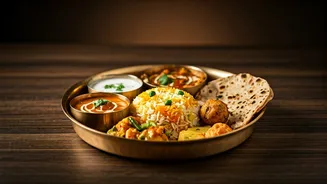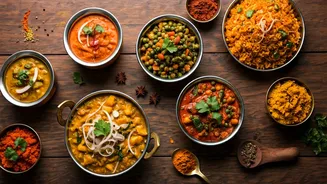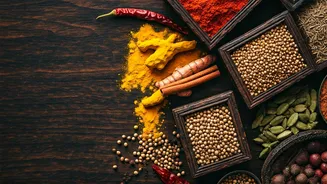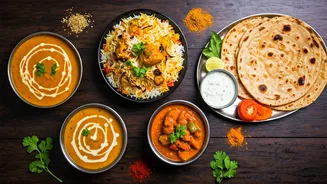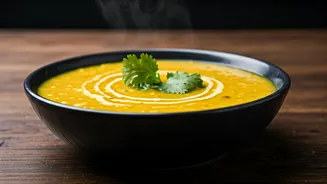Diving Into History
The Mahabharata, a foundational epic of Indian culture, is not just a story of war and dharma; it also offers a glimpse into ancient Indian cuisine. Food
played a vital role in daily life, religious practices, and social gatherings. The recipes were adapted through generations. Understanding the context of the Mahabharata helps appreciate the significance of each dish. This culinary heritage provides more than just nourishment; it connects us to a rich past, offering insights into the ingredients, cooking methods, and the significance of food within the epic's narrative. Preparing and enjoying these dishes allows us to engage with the stories and values of the Mahabharata on a deeper level, offering a unique and flavorful experience.
Recipe 1: Vegetable Curry
Vegetable curries, simple yet satisfying, formed the foundation of meals in ancient India. This recipe, inspired by the Mahabharata era, focuses on seasonal vegetables cooked with aromatic spices. The choice of vegetables would vary based on availability, but common ingredients included gourds, beans, and root vegetables. A base of onions, garlic, and ginger would be sautéed in ghee or oil, followed by the addition of spices like turmeric, coriander, and cumin. The vegetables are then added and simmered until tender, creating a flavorful and nourishing dish. This dish reflects the importance of fresh, locally sourced ingredients and a balanced approach to nutrition, vital to the people during the Mahabharata times. The cooking process is designed to bring out the natural flavors of the vegetables while incorporating the warmth of Indian spices.
Recipe 2: Lentil Soup (Dal)
Lentils were a key source of protein in the Mahabharata era. Dal, a staple in Indian cuisine, offers a filling and nutritious meal. The simplest version involved cooking lentils, such as masoor or moong dal, with water and salt. The soup could be flavored with spices like asafoetida, cumin, and turmeric. Over time, regional variations emerged, often including tempering the dal with hot oil infused with spices. This recipe is a nod to the simplicity and nutritional value of lentils. In the past, dal would have been cooked over a fire in earthenware pots, infusing the dish with a smoky flavor. This recipe captures this essence, offering a hearty and comforting dish, perfect for a balanced diet. The addition of vegetables and a variety of spices would have made dal a versatile dish.
Recipe 3: Rice Dishes
Rice was a valued grain during the Mahabharata era. Simple rice dishes would have been a staple, often served alongside curries and dal. The recipes range from plain boiled rice to more elaborate dishes. For simple preparations, the rice is boiled in water until tender, sometimes flavored with spices or herbs. More complex dishes may incorporate vegetables, nuts, or fruits. These rice dishes were crucial in providing energy and sustenance. This recipe showcases the adaptability of rice as a base for various flavors and ingredients. The way of preparing rice has evolved, but the core essence of simplicity and nourishment remains. This variety shows how different ingredients can be combined to produce a wide range of tastes and textures, suitable for both everyday meals and festive occasions.
Recipe 4: Yogurt (Dahi)
Yogurt, or dahi, was a vital component of the diet during the Mahabharata times, celebrated for its cooling properties and digestive benefits. Dahi could be consumed plain, mixed with fruits, or used in various preparations. This recipe outlines the basics of making homemade yogurt using a starter culture and milk. The warmth and care of the process were essential. The natural tang and creamy texture of homemade yogurt provide a refreshing contrast to spicy dishes. This showcases a tradition that has been passed down through generations. Dahi was, and still is, a versatile food. Simple to make, it can be combined with spices, herbs, and fruits to create a variety of flavors. Its cooling effect also made it a welcome food during the warm climate.
Recipe 5: Sweet Dishes
Sweets were often prepared for special occasions during the Mahabharata era, using ingredients such as jaggery, honey, and seasonal fruits. Simple sweets like rice pudding (kheer) or sweet pancakes were popular. This recipe features a simplified version of a traditional sweet dish, demonstrating how to use natural sweeteners and aromatic spices. The inclusion of sweets in the diet signified joy and celebration. These sweets were often flavored with cardamom, saffron, and nuts. This section celebrates the joy of creating something sweet and simple, which has always been a key part of Indian meals. Using readily available ingredients, this recipe reveals the ease with which you can craft a treat suitable for any occasion, honoring traditions passed through the ages.


